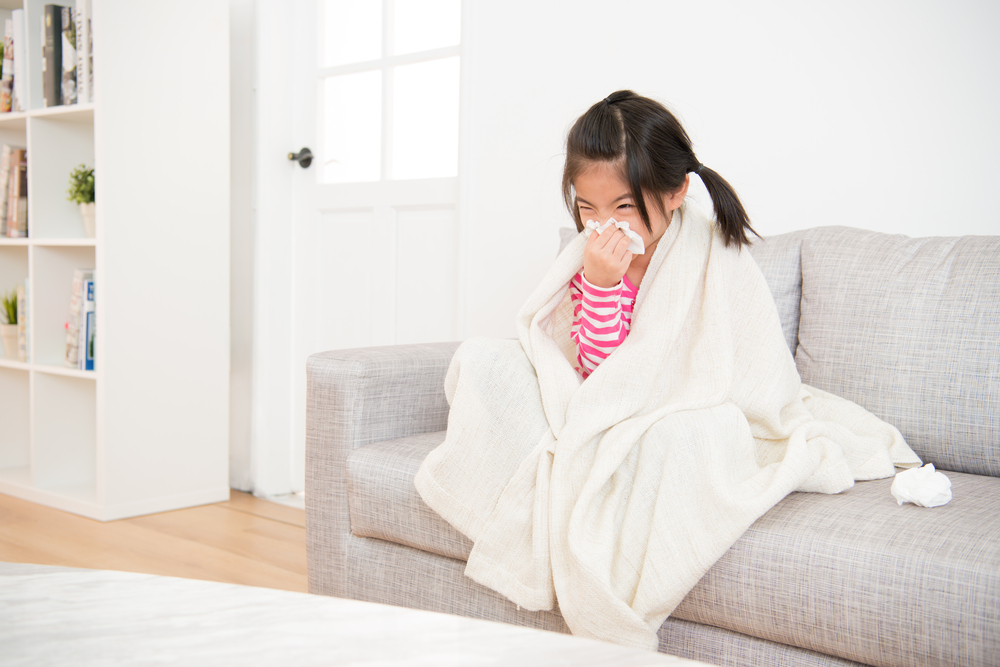Infectious diseases are conditions caused by organisms such as bacteria, viruses, and parasites. Some kinds of infectious illnesses can be transmitted from person to person – we call these communicable diseases. On the other hand, some infectious disorders spread through direct contact, mosquito bites, or consumption of contaminated food. Below are the most common infectious diseases in Filipino children.
Common Cold
First on our pediatric infectious diseases list is the common cold. Experts say it is the most common viral respiratory condition. It causes a runny nose, nasal congestion with or without discharge, and watery eyes.
The common cold is not vaccine-preventable since there are over 200 viruses that cause colds. Learn more about the common cold home treatment here.

Chickenpox or Bulutong
Next, we have chickenpox, an infection caused by the varicella virus. Chickenpox results in fever, loss of appetite, tiredness, headache, and rashes that become itchy, fluid-filled, and then scabby.
Fortunately, chickenpox is vaccine-preventable. Additionally, getting it once often means having lifetime immunity.
Dengue
Dengue is a viral illness transmitted through mosquito bites. Children with dengue may experience mild symptoms like fever, rashes, aches and pains, and nausea or vomiting. However, it can also lead to serious signs, including vomiting blood and bleeding in the gums or nose.
Learn more about dengue here.
Diarrhea
Of course, we also have diarrhea as one of the common infectious diseases in Filipino children. Many cases of diarrhea happen because of food poisoning or ingestion of foods contaminated by viruses (e.g. gastroenteritis), bacteria (e.g. salmonella), or parasite (e.g. amebiasis).
Hepatitis
Hepatitis is a viral infection affecting the liver. There are several types of hepatitis illnesses, each exhibiting various symptoms. The good news is there are available vaccines for hepatitis A and B.
Hand, Foot and Mouth Disease (HFMD)
HFMD is a viral and communicable condition kids can contract from oral ingestion of the virus or exposure to an infected person’s nasal discharge, saliva, and respiratory droplets.
This condition results in mouth sores and rashes on hands and feet. Learn more about Hand, Foot, and Mouth disease here.
Influenza or Trangkaso
Trangkaso is also one of the common infectious diseases in Filipino children.
Kids with flu or trangkaso may come to you complaining of a headache, body aches, sore throat, and stuffy or runny nose. When you check their temperature, you’ll most likely observe that they have a fever.
Flu in children usually lasts for a week, but some symptoms such as fatigue stay for 3 to 4 weeks. Most cases of flu are mild, but complications like pneumonia and ear infection are still a risk.
For this reason, doctors encourage parents to have their kids vaccinated for flu yearly.
Measles, Mumps, Rubella
Next on our pediatric infectious diseases list are measles (tigdas), mumps (beke), and rubella (German measles).
Mumps causes swelling in the parotid salivary glands, leading to swelling in one or both of the jaw areas. Rubella and measles share some symptoms like fever and rashes, but the latter can be more serious.
Measles, mumps, and rubella are vaccine-preventable with the MMR vaccine, which babies receive in their 9th and 12th month.
Conjunctivitis or Sore Eyes
Children get sore eyes or conjunctivitis from hand-eye contact with either virus or bacteria.
If your child has viral conjunctivitis, the symptoms will go away on their own, but they might need supportive treatment, like acetaminophen and something for the itch . In case it’s bacterial sore eyes, your little one may need antibiotic eye drops.
Viral and bacterial conjunctivitis are contagious, so it’s best to keep your child at home until they get better.
Tuberculosis
Kids, and even babies, can get tuberculosis, too, that’s why we included it on our list of infectious diseases in Filipino children. Children with TB do not typically exhibit fever and chills as with adults, but more commonly–poor growth, weight loss, and chronic coughing.
The bacteria that cause tuberculosis can affect the lungs (pulmonary TB) and other body parts (extra-pulmonary TB). Both cases need antibiotic therapy.
Learn more about Infectious Diseases in Children, here.
[embed-health-tool-vaccination-tool]

























